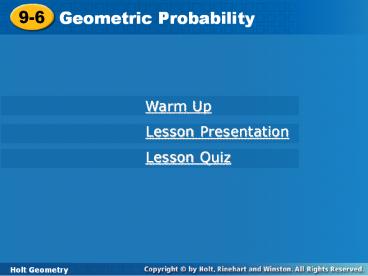Geometric Probability PowerPoint PPT Presentation
Title: Geometric Probability
1
9-6
Geometric Probability
Warm Up
Lesson Presentation
Lesson Quiz
Holt Geometry
2
Warm Up Find the area of each figure. 1.
3.
3 points in the figure are chosen randomly. What
is the probability that they are collinear?
A 36 ft2
2.
0.2
A 20 m2
3
Objectives
Calculate geometric probabilities. Use geometric
probability to predict results in real-world
situations.
4
Vocabulary
geometric probability
5
Remember that in probability, the set of all
possible outcomes of an experiment is called the
sample space. Any set of outcomes is called an
event.
6
Geometric probability is used when an experiment
has an infinite number of outcomes. In geometric
probability, the probability of an event is based
on a ratio of geometric measures such as length
or area. The outcomes of an experiment may be
points on a segment or in a plane figure.
7
(No Transcript)
8
(No Transcript)
9
Example 1A Using Length to Find Geometric
Probability
A point is chosen randomly on PS. Find the
probability of each event.
10
Example 1B Using Length to Find Geometric
Probability
11
Example 1C Using Length to Find Geometric
Probability
The point is on PQ or QR.
12
Check It Out! Example 1
13
Example 2A Transportation Application
A pedestrian signal at a crosswalk has the
following cycle WALK for 45 seconds and DONT
WALK for 70 seconds.
What is the probability the signal will show
WALK when you arrive?
To find the probability, draw a segment to
represent the number of seconds that each signal
is on.
The signal is WALK for 45 out of every 115
seconds.
14
Example 2B Transportation Application
If you arrive at the signal 40 times, predict
about how many times you will have to stop and
wait more than 40 seconds.
15
Check It Out! Example 2
Use the information below. What is the
probability that the light will not be on red
when you arrive?
16
Example 3A Using Angle Measures to Find
Geometric Probability
Use the spinner to find the probability of each
event.
the pointer landing on yellow
The angle measure in the yellow region is 140.
17
Example 3B Using Angle Measures to Find
Geometric Probability
Use the spinner to find the probability of each
event.
the pointer landing on blue or red
The angle measure in the blue region is 52.
The angle measure in the red region is 60.
18
Example 3C Using Angle Measures to Find
Geometric Probability
Use the spinner to find the probability of each
event.
the pointer not landing on green
The angle measure in the green region is 108.
Subtract this angle measure from 360.
19
Check It Out! Example 3
Use the spinner below to find the probability of
the pointer landing on red or yellow.
20
Example 4 Using Area to find Geometric
Probability
Find the probability that a point chosen randomly
inside the rectangle is in each shape. Round to
the nearest hundredth.
21
Example 4A Using Area to find Geometric
Probability
the circle
The area of the circle is A ?r2
?(9)2 81? 254.5 ft2.
The area of the rectangle is A bh
50(28) 1400 ft2.
22
Example 4B Using Area to find Geometric
Probability
the trapezoid
The area of the rectangle is A bh
50(28) 1400 ft2.
23
Example 4C Using Area to find Geometric
Probability
one of the two squares
The area of the two squares is A 2s2
2(10)2 200 ft2.
The area of the rectangle is A bh
50(28) 1400 ft2.
24
Check It Out! Example 4
Find the probability that a point chosen randomly
inside the rectangle is not inside the triangle,
circle, or trapezoid. Round to the nearest
hundredth.
Area of rectangle 900 m2
The probability of landing inside the triangle
(and circle) and trapezoid is 0.29.
Probability of not landing in these areas is 1
0.29 0.71.
25
Lesson Quiz Part I
A point is chosen randomly on EH. Find the
probability of each event.
26
Lesson Quiz Part II
3. An antivirus program has the following cycle
scan 15 min, display results 5 min, sleep 40
min. Find the probability that the program will
be scanning when you arrive at the computer.
0.25
4. Use the spinner to find the probability of the
pointer landing on a shaded area.
0.5
27
Lesson Quiz Part III
5. Find the probability that a point chosen
randomly inside the rectangle is in the triangle.
0.25

